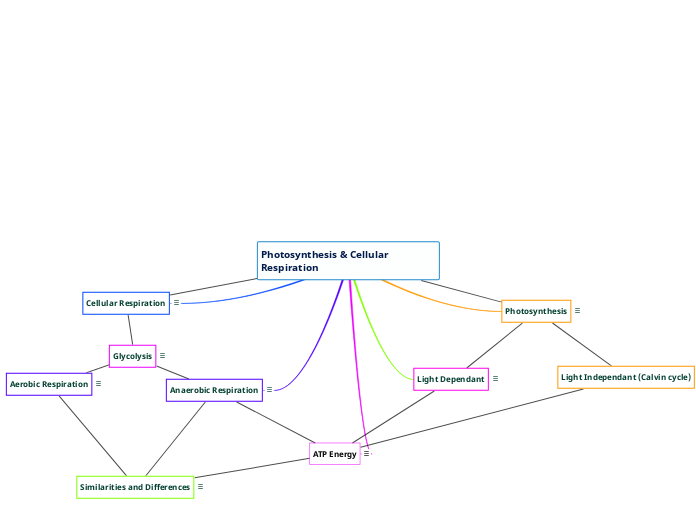
Photosynthesis is the process in which light energy from the sun is converted into chemical energy and stored sugar (glucose). Photosynthesis takes place in chloroplasts found in plant cells. Chloroplasts are specialized cell structures known as organelles. The pigment that absorbs sunlight is called chlorophyll and it is green. During photosynthesis plants take in carbon dioxide CO2 and water H2O from both the soil and air. Once inside the plant the water is oxidized (loses electrons) and carbon dioxide is reduced (gains electrons). This process transforms the two elements into glucose that the plant can then use for energy.
Photosynthesis occurs in two stages the first being Light Dependant. Plants capture and absorb light energy for use in photosynthesis the plant then creates Adenosine Triphosphate (ATP) energy to power the rest of the process. This all occurs in the plants Chloroplasts. The light energy that is captured and absorbed from the sun is used to create ATP and NADPH energy for the plant to use these are high in energy. Light Dependant Photosynthesis creates oxygen gas O2 as a waste product. The overall goal of Light Dependant photosynthesis is to make energy in ATP and NADPH form from sunlight and water. 6CO2 + 6H2O + light energy ----> C6H12)6 + 6O2
Cellular Respiration also referred to as "cell breathing" occurs in all living things and creates ATP energy to fuel other reactions within cells. C6H12O6 + CO2 -----> 6 CO2 + 6 H2O + 32 ATPglucose + oxygen -----> carbon dioxide + water + energy Cellular Respiration has two stages both of which depend on whether or not oxygen (O2) is present. If oxygen is present Aerobic Respiration occurs. If Oxygen is not present Anaerobic Respiration occurs.
Anaerobic Cellular Respiration can only occur is there is no oxygen present after Glycolysis. In order for Anaerobic Cellular Respiration to work the cell must recycle materials used during the Glycolysis process. This recycling process is called fermentation and the product of this reaction is alcohol. Fermentation occurs because without oxygen sugars (glucose) are broken down by enzymes and microorganisms as there is a lack of oxygen. Fermentation is a lot quicker than Aerobic Cellular Respiration but produces less ATP energy. The overall energy total for Anaerobic Cellular Respiration is 2 ATP molecules. Step 1 Glycolysis: 2 ATP molecules Step 2 Fermentation: 0 ATP molecules Total= 2 ATP
Adenosine Triphosphate or ATP c=energy used by cells to power important processes like Photosynthesis and Cellular Respiration. ATP energy has three phosphate groups attached and when one phosphate is broken off it releases a ton of energy which fuels other reactions in cells. There are two processes in which cells make ATP energy. One process is Photosynthesis which is the process used by plant cells, algae and bacteria. Photosynthesis uses water, carbon dioxide (CO2) and sunlight to make ATP which is then used to create glucose or food for the plant. The second process is Cellular Respiration which occurs in all living cells animal, plant, bacteria etc... Cellular Respiration uses glucose (C6H12O6) and Oxygen (O2) to make ATP energy.
Aerobic Respiration only occurs is oxygen is present after Glycolysis occurs. Aerobic Respiration occurs in a cells mitochondria. The mitochondria creates ATP energy for the cell to use this is why we refer to the mitochondria as the 'powerhouse' of the cell. Inside the mitochondria two processes take place:Kreb's Cycle (Citric Acid Cycle) which makes 2 ATP molecules Electron Transport Chain which makes anywhere from 32-34 ATP molecules. The overall energy total for Aerobic Cellular Respiration is 36-38 ATP molecules. Step 1 Glycolysis: 2 ATP molecules Step 2 Kreb's Cycle: 2 ATP molecules Step 3 Electron Transport Chain: 32-34 ATP molecules Total=36-38 ATP
Glycolysis is the first step in Cellular Respiration. 'Glyco' means sugar and 'lysis' means break down. During Glycolysis 2 ATP energy molecules are created which happens in the cells cytoplasm. Step two of Cellular Respiration is a simple check to see if oxygen is present. From this check either Aerobic or Anaerobic Respiration will occur.
The second stage of photosynthesis is Light Independent Photosynthesis also called the Clavin Cycle. The Calvin cycle uses ATP energy to produce glucose (sugar) for the plant. This occurs in the plants cytoplasm and the chemical reactions transform carbon dioxide (CO2) onto glucose (C6H12O6). The glucose is formed using the energy provided from the ATP and NADPH molecules. The overall goal of the Clavin Cycle is to make glucose (food) out of carbon dioxide (CO2), ATP and NADPH energy.
Similarities:Aerobic and Anaerobic Respiration both make ATP energy for cells to use to fuel reactions. Both processes use glucose as the starting molecule for reactions. Differences: Aerobic Respiration uses oxygen Anaerobic Respiration does not. Aerobic Respiration produces more ATP energy than Anaerobic Respiration due to the Fermentation process that occurs.